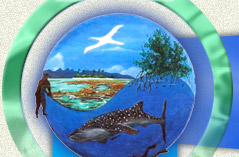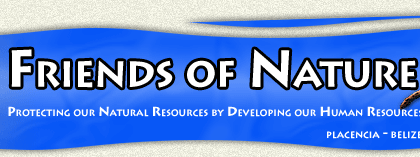Placencia Lagoon:
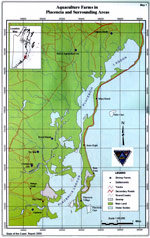 | | (Click image to enlarge view) |
Placencia Lagoon lies behind the Placencia peninsula. It is a narrow, 24-km long estuary that is mainly shallow, (1-2 meters), with a few deeper holes and channels. Its width and area are somewhat variable because of enormous marshy wetlands that blanket most of the inland coast. The Lagoon is connected to three important rivers: Mango Creek, Jenkis Creek, and Waha Leaf Creek. Seagrass beds occupy more than 50% of the lagoon bottom.
The lagoon is home to a remarkable suite of biodiversity including several endangered and magnet species like the Jabiru Stork, Morelet's crocodile, and West Indian manatee. Both bottle-nosed and Atlantic spotted dolphins also frequent the Lagoon. Much of the coast is lined with mangroves whose roots are encrusted with a rich variety of sessile life - shellfish, sponges, anemones, and algae - and provide shelter for juveniles of many commercial species of fish. The savanna ecosystem on the west coast of the lagoon leads into a dry tropical forest that provides a biological corridor to the Cockscomb Jaguar Reserve.
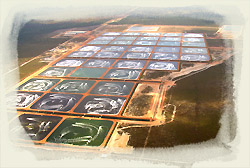 However, extensive development is underway on both sides of the Lagoon. The inland coastal savanna has proven ideal for shrimp farming, and the entire western margin is lined thick with them. These farms dump waste from their spent ponds which includes shrimp feces and excess feed into the mangroves assuming that these nutrients will be taken up by the mangrove ecosystem. Little research has been done on the carrying capacity of mangroves, so the impact of several farms on the same lagoon could be potentially devastating. The farms also construct massive earthworks that are constantly eroding and silting up small creeks and waterways. Some of these clays contain alumina which can be toxic to the flora and fauna of the region.
However, extensive development is underway on both sides of the Lagoon. The inland coastal savanna has proven ideal for shrimp farming, and the entire western margin is lined thick with them. These farms dump waste from their spent ponds which includes shrimp feces and excess feed into the mangroves assuming that these nutrients will be taken up by the mangrove ecosystem. Little research has been done on the carrying capacity of mangroves, so the impact of several farms on the same lagoon could be potentially devastating. The farms also construct massive earthworks that are constantly eroding and silting up small creeks and waterways. Some of these clays contain alumina which can be toxic to the flora and fauna of the region.
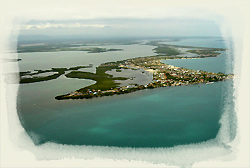 On the peninsular side, the booming tourism industry has brought hoards of visitors enjoying the sandy beaches and looking for vacation homes. All this development brings with them the attendant environmental problems including leaching of sewage through the sandy substrate of the lagoon and extensive clearing of mangroves along the lagoon shore. The combination of tourism and shrimp-farming industries could overwhelm the ecology of Placencia Lagoon, particularly the rich sea grass beds that flourish in its shallow waters and are prime feeding ground for manatee.
On the peninsular side, the booming tourism industry has brought hoards of visitors enjoying the sandy beaches and looking for vacation homes. All this development brings with them the attendant environmental problems including leaching of sewage through the sandy substrate of the lagoon and extensive clearing of mangroves along the lagoon shore. The combination of tourism and shrimp-farming industries could overwhelm the ecology of Placencia Lagoon, particularly the rich sea grass beds that flourish in its shallow waters and are prime feeding ground for manatee.
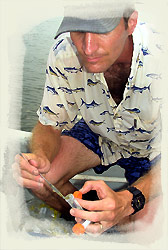
Monitoring of some parameters has already begun. Isotopic signatures of N and C have been determined for several species at different trophic levels in the lagoon. Preliminary data show a few disturbing trends: the mouth of one creek near a shrimp farm showed low dissolved oxygen. The upper basin has little sea grass, the main forage for manatee, even though anecdotal reports describe meadows of sea grass ten years ago this is swiftly declining.
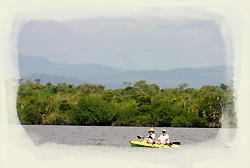 Friends of Nature is concerned about the future of Placencia Lagoon and has recently begun discussions with the Government of Belize to formally protect the lagoon. Properly managed, the Placencia Lagoon could have huge positive impact, increasing the flow of tourism and revenue to the area. Kayaking, birding, mangrove snorkeling, manatee watching are all readily available within the lagoon. The convenience of being able to use the lagoon irrespective of the weather would mean that almost every visitor to the area would find some activity in which they can engage. FoN would like to encourage, train and assist local small tourism providers to establish businesses that are eco-friendly and environmentally sustainable.
Friends of Nature is concerned about the future of Placencia Lagoon and has recently begun discussions with the Government of Belize to formally protect the lagoon. Properly managed, the Placencia Lagoon could have huge positive impact, increasing the flow of tourism and revenue to the area. Kayaking, birding, mangrove snorkeling, manatee watching are all readily available within the lagoon. The convenience of being able to use the lagoon irrespective of the weather would mean that almost every visitor to the area would find some activity in which they can engage. FoN would like to encourage, train and assist local small tourism providers to establish businesses that are eco-friendly and environmentally sustainable.
Gladden Spit | Lagoon | Laughing Bird | Enforcement
About Friends of Nature | Research | Protected Areas | Newsletter | Contact Us | 